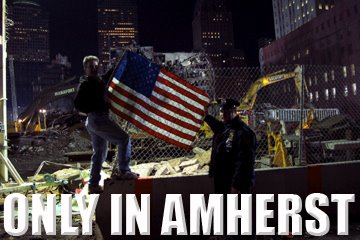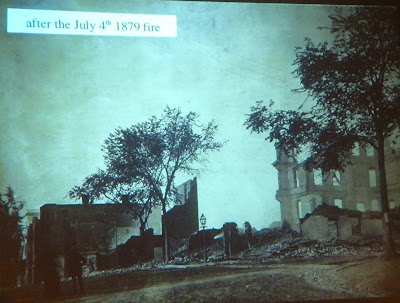Yes, Amherst existed before UMass (and Amherst College). Town center circa 1839
With Umass Amherst almost ten times larger than our other two colleges combined, perhaps the Amherst of today is better described as a "University town" . But it wasn't always so.
The founding in town center of the Amherst Academy (1814), which soon became one of the top private schools in the state, set in motion a paradigm shift. Because soon thereafter, as an educational outgrowth, Amherst College was founded on top of a hill (1821) at the southern end of town center.

Johnson Chapel, Amherst College built 1837
This shifted the balance of social/economic power away from the East Village, which had the initial advantage of water power via the Fort River, to what is now the heart of downtown Amherst.
And whenever a strong magnet arises for people of all persuasions -- in this case education -- the shopkeepers are close behind.
Merchants Row, 1870. Buildings in foreground were "mixed use" with Fraternities above ground floor
In a standing room only presentation yesterday at the Strong House Museum in town center, local historian Ed Wilfert brought to life the story of "Merchants Row", a block of buildings on the west side of the town common with pretty much the same footprint today as 150 years ago.
Merchants Row today
And at the southern end, the First Baptist Church (built in 1835).
First Baptist Church recently renovated by Amherst College for office space
The Amherst House
Historic photos from Jones Library collection
All that remains after the July 4, 1879 fire
The Amherst Hotel was rebuilt as nice as ever but then in 1926 burned down again, even though by then, with Town Meeting approval, town center had running water piped in from the high ground of neighboring Pelham.
Every time buildings burned in the downtown land underneath was dug out a little deeper before rebuilding, and the soil recycled over on the town common which was originally -- by today's standards -- wetlands.
Ed Wilfert, "perpetual amateur scholar"
While the stately Amherst Hotel is now long gone, Amherst still has a bustling Merchants Row. UMass, to the north, has become a veritable Juggernaut -- the flagship of higher education in the state.
Amherst Town Meeting is still around, and too many years ago a town committee highly recommended the town build a new fire station. Thus far, a recommendation unfulfilled.
Those who fail to learn from history ...
#####
The Jones Library atrium currently has Ed Wilfert's presentation materials about Merchants Row on display (and you can often spot Ed around the library).




































7 comments:
Wow, that looks like is was great presentation! I'm sorry I missed it. Thanks for sharing Larry.
It was my pleasure (especially after covering Town Meeting).
I should have mentioned Ed has his entire presentation at the Jones Library atrium on display.
Not to mention that a parking lot violates the conditions under which the former Amherst Academy land was given to the town.
Tune in to WGBY tonight at 8 for what sounds like an interesting documentary on the origins of UMASS.
Radical Idea: Umass Amherst & America's Education
Prior to 1855, every town was required to have a Congregational Church -- and much as Amherst had split off from Hadley, you can see how Amherst would have eventually split into five different towns, each centered around its own Congo Church. Remember too that the Baptists were giving an exemption in 1820 for paying for the Congo church (taxpayer supported until 1855)if they could prove they could support a Baptist church.
And never forget why Amherst College was formed -- there was a theological schism at Harvard and the religious zealots, convinced that Harvard was becoming way too liberal, went out to then-rural Amherst and formed their own college.
Speaking of fire, I'm reminded of something I saw reading the Amherst College yearbooks from the 1930s. It appears that there was a tradition of the Freshmen maintaining a vigil around a campfire and the Sophomores trying to prevent them from doing so.
Well, one year in the early '30s, members of the Sophomore class apparently "rolled a barrel of gasoline down the hill" -- towards the Freshmen assembled around their campfire -- the rest is left unstated but as a "barrel" of gasoline had to be at least 30 gallons of it, one can presume what would happen when a barrel of it was rolled into an open fire.
I do not approve of throwing beer bottles at police officers - I absolutely do not -- but I think this gives perspective on the matter. Rolling a "barrel of gasoline" down a hill toward people who are around an open fire. Wow...
So much for our mistaken belief in the halcyon days of yore.
Too bad they didn't have the "Darwin Awards" back then.
Post a Comment